California Dreamin’ Pt3
Greetings!
Last week’s essay was very different for me in that it had no animals, and not even any wings! Even more unusually, and a bit uncomfortably, I even allowed a little of my innermost feelings to creep in. But if you watched the videos as I suggested, you may have picked up a deep resonance with what I have been trying to do throughout my photography – namely just to encourage all of us to see what is around us and to rejoice in it, and hopefully to treasure it. So this week’s pictures concentrate on some of the birds and animals we saw during our recent trip to California, especially ones that I haven’t seen on the East Coast.
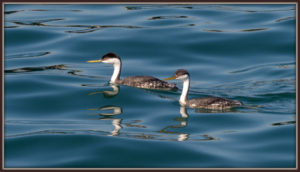
When I first saw these birds in the ocean at Santa Barbara, my first thought was that they were some kind of loon, but having checked on the web, I now think they are Western Grebes (Aechmophorus occidentalis).
The next picture at first sight is rather dull and unexciting, and we saw many of them on Catalina Island.

Upon closer inspection, it is still a rather unglamorous looking bird, but became interesting when I realized that it is not just a crow, but rather a raven. Technically a Common Raven (Corvus corax), it is common in the western and southwestern US, and across Canada, but is not found on the East Coast, so it was a new species on my list.
While things that fly will probably always be my favorites, I won’t deny that it is fun and interesting to see large animals in the wild, such as the Elephant Seals featured two weeks ago. These next three images are of more creatures we saw on our visit to California.
The first picture shows part of a herd of Aoudads (aka Barbary Sheep) that roam freely on the property that surrounds Hearst Castle. They were originally introduced by Mr. Hearst. The same story applies to the Zebra in the second picture, which was taken about 20 minutes after the picture of the sunset at Piedras Blancas I included two weeks ago. By that time the sun had well and truly set, so the photographers amongst you will appreciate the the implications of having to go to an ISO of 12800, and a shutter speed of 1/100 sec hand-held with a focal length of 300mm! The American Bison in the third picture offered its own challenges, this time due to an abundance of bright light and deep shadows. This Bison is one of many that wander over large tracts of Santa Catalina Island.
Large animals tend to be rather drab, so for some color let’s turn to some Californian hummingbirds.
The first of those two pictures looks very much like our familiar (on the East Coast) Ruby-throated Hummingbird, but since those are rare vagrants on the California Coast, this is most probably something else. Thanks to the web, I strongly suspect this is an Anna’s Hummingbird (Calypte anna). I took that picture in Santa Barbara, whereas the second picture was in Rancho Palos Verdes, so they do not show the same individual. The second picture clearly shows the bright iridescent fuchsia head and neck which are characteristic of an adult male Anna’s Hummingbird.
We stopped briefly at Morro Strand State Beach, where we noticed a flock of large shorebirds with very long bills, which looked unlike anything I had seen in Virginia or North Carolina.
Closer examination showed that some of them had down-curving bills (the majority of the birds in the left-hand image), which subsequent research indicated to be Long-billed Curlews (Numenius americanus), while the ones with slightly up-curved bills seem to be Marbled Godwits (Limosa fedoa).
I made a point earlier in this essay that the large animals featured were all essentially wild, and in general I refrain from taking pictures of captive animals. However, some rules are meant to be broken – at least under the right circumstances. So when, on Catalina Island, we found ourselves at a sanctuary which not only was in the forefront of the battle to save and re-introduce the Bald Eagle after the DDT debacle, but now has a rescued Golden Eagle (Aquila chrysaetos), I had to bend my rule!
Our bus only stopped for a few minutes at this out-of-the-way location, and the only photographic opportunity was to take snapshots through the wire mesh of the bird’s enclosure. The holes in the mesh were smaller than the diameter of my lens, and the Golden Eagle was – and you’ve heard this before – basically silhouetted against a bright sky, so these pictures can only hint at the majesty of the bird.
Still on Catalina, but now back in the “city” of Avalon, I was surprised when a hawk flew past and landed on the roof of a row of shops right across the street from the beach – once again outlined against a bright sky!
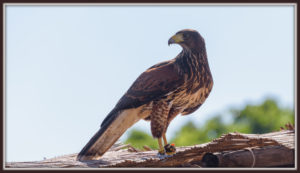
I hardly had time to absorb what I had just seen when the hawk took off again, and flew down to the gloved hand of its owner!
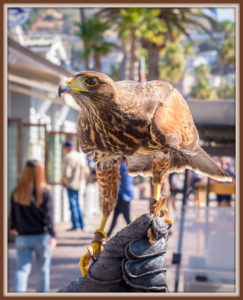
I spoke briefly with the falconer, who confirmed my suspicion that it was a Harris’s Hawk (Parabuteo unicinctus). This image actually contains a “selfie”. If you look very carefully in the bird’s eye, you can see a reflection of my pale hat, darker clothes, and white sneakers!
I hope this selection of images suggests why I would dearly like to go back to California with more time to devote to photography.
Have a great week, and keep your eyes open to the beauty that surrounds us!
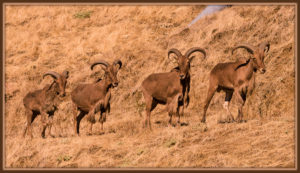

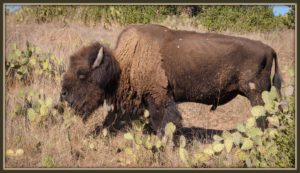

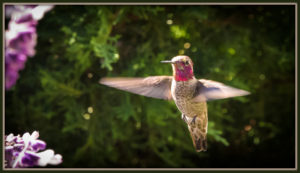
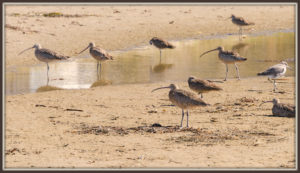
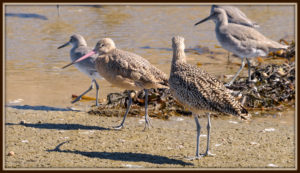

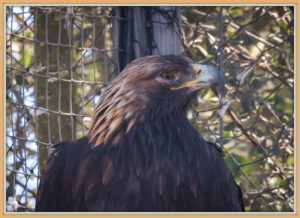
One thought on “California Dreamin’ Pt3”
Years ago when I was teaching in Sutton we had a visit from a bird of prey centre. They brought all sorts of wonderful birds, mainly owls and flew them in the school hall. One of the birds was announced as being “an arris or”. I had never heard of those before and was very interested in it. Some time later I realised it was actually a Harris Hawk!!
Comments are closed.